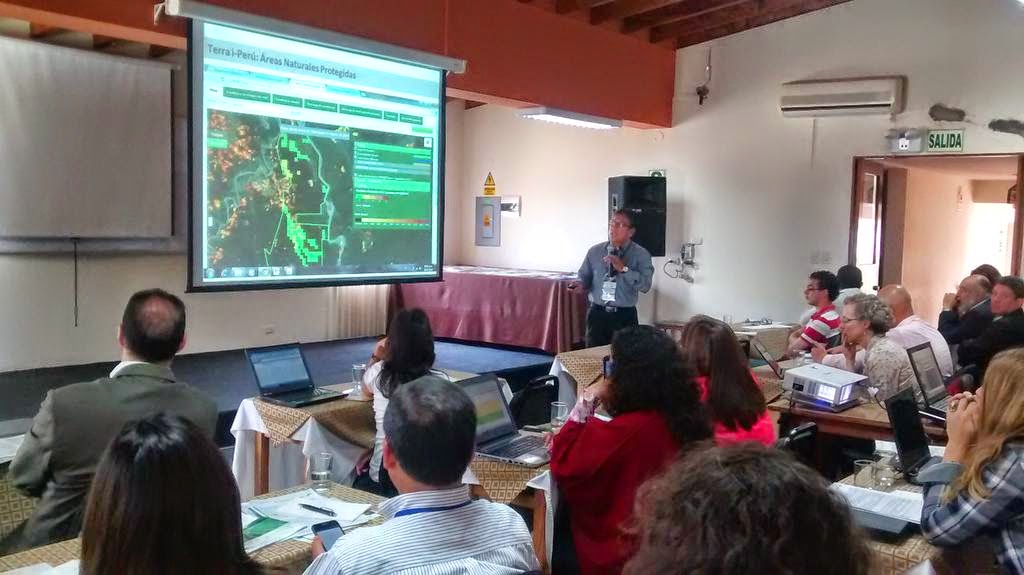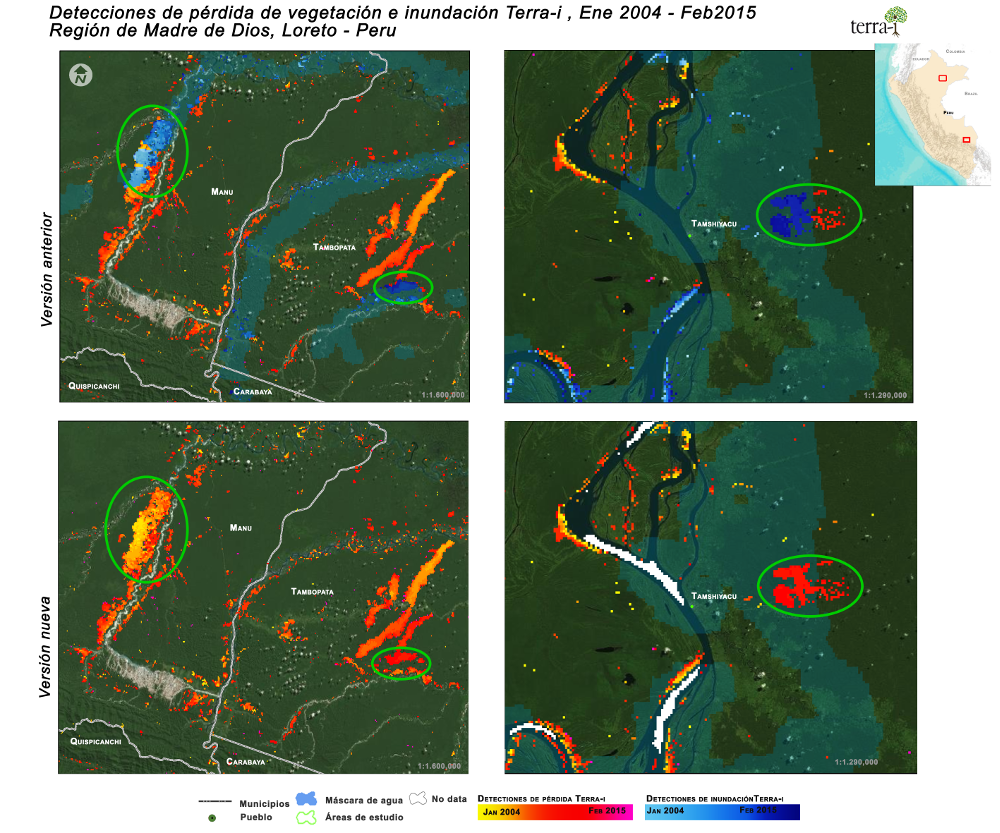

Officially launched in April 2014, Terra-i Peru has been applied as an early warning system for land cover and land-use change in Peru. This collaboration is the result of a collaborative framework agreement signed between the International Center of Tropical Agriculture (CIAT) and the Peruvian Ministry of Environment (MINAM). At http://terra-i.org/terra-i/data/data-terra-i_peru one can visualize Terra-i results in Peru and overlay them with relevant map layers such as mining concessions, forest concessions and the National Service of protected Areas (SERNARP) ground-validated monitoring results.

Figure 1, William Llactayo presenting Terra-i during COP20, Lima, Peru.
One year later, the system has been greatly improved to fit the specificity of Peruvian landscapes. Very recently, experts from the General Directorate of Land Management (DGOT) helped Terra-i staff to improve the calibration of Terra-i models based on their knowledge of current land use change dynamics in Peru. For instance, as shown on Figure 2, important new areas of changes were misclassified as floods. This has been corrected and an adjusted dataset is now online.

Figure 2, important areas of deforestation misclassified by the system as floods.
We also recently implemented the monthly generation of data for Peru. The data will therefore be updated on the platform during the first week of each month. To make this possible, the models were calibrated for not using data from TRMM satellite as it is finalizing its mission and provides data less frequently. Precipitation data will be included in the models again once the Global Precipitation Measurement Mission (GPM http://pmm.nasa.gov/gpm) will be producing data.
In 2015, Terra-i collaboration with MINAM will be strengthened through a series of workshops. The main objective of these workshops is to build capacity for national technicians to directly produce vegetation loss data using Terra-i at MINAM headquarters. Furthermore, the Terra-i team will work together with the MINAM-DGOT specialists to adapt the methodology to the Peruvian context using high resolution forest loss datasets.
Global datasets such as Terra-i cannot replace local expertise. Nonetheless, the combination of both global coverage data and local experts’ knowledge leads to a more comprehensive understanding of the trends and patterns of changes. The Terra-i system can easily be calibrated for specific areas and we would like to invite our users to help us to improve our dataset.

The Terra-i team together with CRS El Salvador under the Raices project carried out a virtual workshop through the teams platform to technicians from the Ministry of Environment and Natural Resources, CARITAS, Universidad El Salvador, CENTA, about the Mapping of land cover using remote sensors and open source tools such as GEE, SEPAL and QGIS- Plugin Semi Automatic Classification.

Near real-time vegetation loss detection in Southwestern Ethiopia: calibration, validation, and implementation of the Terra-i system

The Alliance of Bioversity International and the International Center for Tropical Agriculture (CIAT) (the Alliance) conducted a training for local stakeholders on the use of Terra-i as part of the collaboration with the Netherlands Development Organisation – SNV in the Coffee Agroforestry and Forest Enhancement for REDD+ (CAFÉ-REDD) Project.


From May 8-12, 2017, the Terra-i team, together with staff from the DGOTA of Peru's Ministry of Environment, carried out the first field validation of vegetative land cover changes detected during Terra-i monitoring for 2016 and 2017, using the technology UAV. This work was carried out under the framework of the project “Sustainable Amazonian Landscapes”. The team carried out over-flights with a Phantom 3 advanced rotor drone and a fixed-wing Ebee drone in seven townships of Yurimaguas. The objective of this work was to recognize the dynamics of land cover and land use changes in the region while at the same time to validate the accuracy of the detections of forest loss being monitored by Terra-i in Yurimaguas.

The Terra-i team has worked hard on renovating Terra-i’s website since early this year. A set of new features on the website provides interactive contents and facilitates adaptation to the mobile devices of our users. The fresh website was developed using the latest update of an open-source, Java-based web system, Magnolia CMS 5.4.4. This update was customized to add different categories of interaction such as news, vegetation cover changes, and information, among others.

Globally more than 1 billion people depend on forests for their livelihoods. Forests play a crucial role in climate regulation, ecosystem services provision and regulation, water supply, carbon storage and many other functions that support biodiversity. Currently the global rate of deforestation is substantial, and there is a growing need for timely, spatially explicit data that flag natural vegetation changes due to human activities.

The latest update of Terra-i has been used with the Co$ting Nature ecosystem services assessment tool to understand the impacts of recent forest loss in Colombia on biodiversity and ecosystem services.

During the 1st and 12th of June 2015, the Terra-i team, together with the Instituto de Investigaciones de la Amazonía Peruana (IIAP) and the Universidad Nacional Agraria La Molina (VLIR-UNALM), conducted the second field validation of the data produced by the Terra-I system. This time, the study area was the Yurimaguas district, Alto Amazonas province, Loreto region (Peru). We used information on populated places, main roads, rivers and information on land cover changes detected for 2013, 2014 and 2015 to define the 65 sampling points (or Terra-I pixels) for the validation process (Figure 1).